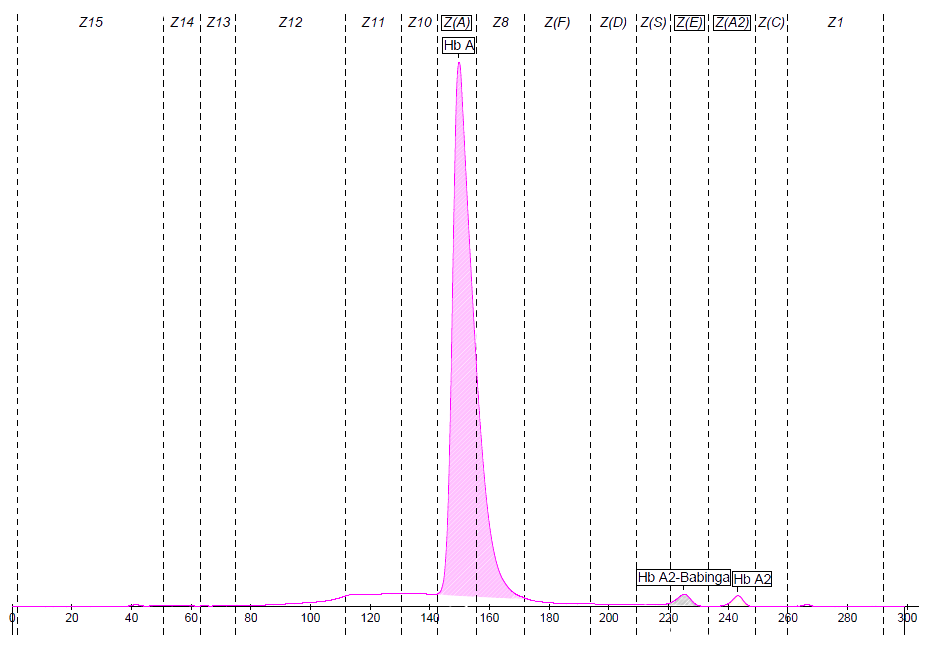General information
Globin chain involved
Status
Heterozygous
Migration zones
Migration positions
225
Sickle Cell Disease: No
Thalassemic variant: No
Capillary Electrophoresis
Fractions
Value %
Hb A
97.5
Hb A2-Babinga
1.5
Hb A2
1.0
Comments
Unusually and undeterminedly, the percentage of the abnormal fraction, Hb A2-Babinga, is not equal to Hb A2 but higher than it.
Mutation data
Heterozygous Hb A2-Babinga
Mutation
HGVS Nomenclature
Delta 136(H14) Gly>Asp
HBD:c.410G>A
Hematological parameters
Name
Result
RBC Count
No information
Total Hemoglobin
No information
MCV
No information
MCH
No information
Blood smear
No information
Other analysis
No information
Comments on hematology
Normal
Clinical context
Clinical presentation
Due to their low concentration, Delta-globin chain variants are asymptomatic
Clinical risk
No data
Variant information
Stability
No data
Oxygen affinity
No data
Ethnicities in literature
Found in Black African populations: met in several Babinga Pygmies (frequency 1-2%) in Central African Republic, in a few Black families in the USA, in a Colombian male and his relatives living in Paris, and in a few Portuguese, English, and Dutch families (ethnicity not mentioned)
Comments on variant information
The rare variant Hb A2-Babinga has been found in combination with Hb S and HPFH.
Scientific Literature
Scientific references
- https://pubmed.ncbi.nlm.nih.gov/5678016/ de Jong WW. et al., Nature. 1968 Sep 28;219(5161):1360-2.
- https://pubmed.ncbi.nlm.nih.gov/5766005/ Huisman TH. et al., Biochim Biophys Acta. 1969 Feb 4;175(1):223-5.
- https://pubmed.ncbi.nlm.nih.gov/6207140/ McRoyan DK. et al., Hemoglobin. 1984;8(4):413-6.
- https://pubmed.ncbi.nlm.nih.gov/3986955/ Jaeger G. et al., Bull Soc Pathol Exot Filiales. 1985;78(1):89-93.
- https://pubmed.ncbi.nlm.nih.gov/17916081/ Morgado A. et al., Eur J Haematol. 2007 Nov;79(5):422-8.
- https://pubmed.ncbi.nlm.nih.gov/20678137/ Phylipsen M. et al., Int J Lab Hematol. 2011 Feb;33(1):85-91.
- https://pubmed.ncbi.nlm.nih.gov/24601842/ Khalil MS. et al., Hemoglobin. 2014;38(3):201-6.
Globin Chain involved
Status
The term "Double Heterozygous" refers to cases of heterozygosity on different globin chain types, while the term "Compound Heterozygous" refers to cases of heterozygosity on the same globin chain type.
For example, S/G-Pest is a Double Heterozygous case (beta and alpha-globin chains are mutated) and S/C is a Compound Heterozygous case (only beta-globin chains are mutated).
Migration zones
Migration positions
Sickle Cell Disease
Thalassemic variant
Capillary Electrophoresis
Variant information
Ethnicities are provided for informational purposes only and are based on scientific literature and conference posters.
A hemoglobin variant may therefore be present in populations of ethnic origins or countries not listed here.

